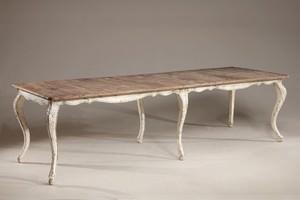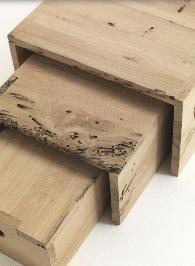Home furnishings from reclaimed wood
Post from EditorialsWood is a natural material that gives warm sensations. Now it is also the emblem of sustainability and therefore the undisputed star of new design products.
Old wood for new pieces of furniture and accessories
Maybe for its being a natural material that gives you warm sensations, maybe because, now more than ever, it is the emblem of sustainability, the fact is that wood has an increasingly important role in the world of building industry and furnishing, in all its forms. This material stands even more out of its already wide usage if compared to the massive, continuous, inevitable invasion of the many innovative and hyper performance materials which now affect every productive sector of the furniture industry.
This material stands even more out of its already wide usage if compared to the massive, continuous, inevitable invasion of the many innovative and hyper performance materials which now affect every productive sector of the furniture industry.
Then it becomes even more interesting to find out how much wood is taken into account in the selective design world, if there are companies that do not only use, but even re-use it, recovering the material from old productions and artifacts, giving it back new life.
This long, painstaking and very valuable work takes the form of products that are perfectly in line with the latest design and especially with the dictates of the most uncompromising philosophy of sustainable production.
Let me point out only a few articles, the production is really rich and the pieces, because of the nature of the project, have unique characteristics, different from each other, just like so different are the origins of the wood itself.

The catalog is composed of single pieces, especially tables, modular bookcases, sideboards, cupboards, all of them strictly in solid wood with natural finish or painted with ecological paints, using soft colours. They also privilege surface finishes that leave exposed the natural grain of the wood.
The metal elements do not disturb, indeed enhance visual impact that emphasizes both the experienced handicraftsmanship and the origins of the materials.
Wood handicrafts and new design in home furnishings
The skill of the craftsmen of wood is enhanced by the search for new stylistic experimentation in the new business project by Icons Furniture , that for its first collection relies on studies of young designers for the design of seven solid wood products.
Not any wood, among other things, but oak wood recovered from the briccole, the characteristic piles of Venice's lagoon. The marks left on this wood by water over time, instead of being a material defect to be corrected, becomes rather an added value to enhance, with its inherent richness which is the mirror of the history of this city.
So each product becomes, ![]() inevitably, a unique piece, as well as unique and different from all the others is the piece of recycled wood that has served to make it happen.
inevitably, a unique piece, as well as unique and different from all the others is the piece of recycled wood that has served to make it happen.
Original is also the choice of names for these products: Botero is a table that well describes the combination of art and technology, starting from the legs, apparently disproportionate, just like the subjects of Colombian artist's pieces.
Carroponte bases its concept on the union of the elements air and earth: the solid iron structure is reminiscent of the bridge crane, while the wooden top refers to the lines of the wings of an airplane. ![]()
It could only be called Fibonacci the library designed in modules such scrupulously that it remembers the sequence by the well-known mathematician, so as to give birth here to a piece of furniture that incorporates mathematical intuition and translates a spatial balance and proportionality, for an optical unsurpassed effect.
Paradigma is the collection that exploits the small irregularities of the briccola to create small joints and give a unique, natural and realistic effect to the table and bookcase with structural unpainted metal inserts. The rectangular modules of the library are of different sizes, with square holes that allow different combinations of assembly, to adapt to different types of environment.
![]()
Rebirth is clearly a symbol of this first production by Icons: it is a table that is inspired by the traditional Italian lines in order to propose them in a modern style. Triangola owes its peculiarity to the concept of the legs, tied to the top by means of iron supports that are reminiscent of the briccole.
Oak wood, from Venetian briccole to design furniture
Briccole once again, even more declared, beginning with the name of the competition  to involve internationally renowned designers in the Riva 1920 project: Briccole Collection, in fact.
to involve internationally renowned designers in the Riva 1920 project: Briccole Collection, in fact.
A lot are the names that have signed up, 34 to be precise, including Philippe Starck, Paola Navone, Alessandro Mendini, Matteo Thun, Mario Botta, just to name a few. All of them have joined the group and worked with enthusiasm, together with the common goal of reinterpreting, while leaving intact the ecological value, this presence of the typical landscape of the lagoon, the briccole, now transformed into an object of art.
80837 REGISTERED USERS










